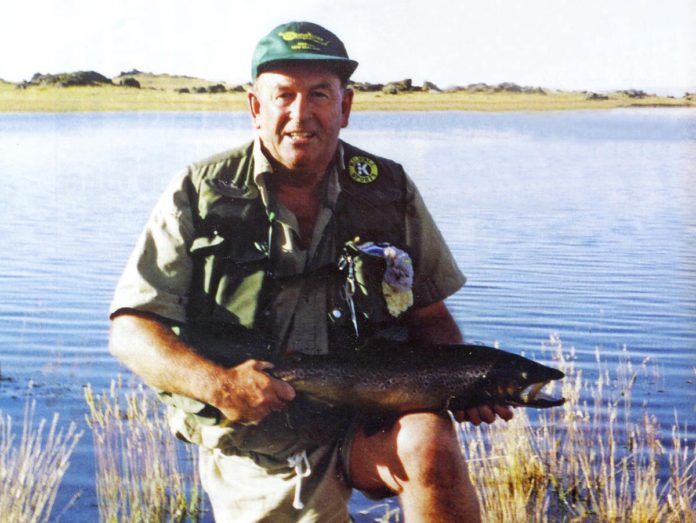Monty and brown trout at Poolburn Dam.
Poolburn Dam Brown Trout Fishing – part of the Old Dunstan trail from the Styx Basin
History of Poolburn Dam
The Poolburn Dam or Reservoir is situated on the Ida Valley side of the Rough Ridge Range. lt was completed in 1931 as a storage area for irrigation water to feed the fertile land on the floor of the Ida Valley. lt covers over 300 hectares when full and is administered by the Ida Valley Irrigation Company. The area now covered by water once had five hotels alongside this popular goldfields road The most famous was the Drunken Woman Inn named by travellers after its owner. The dam has had both brown and rainbow trout introduced into its water but has evolved as a brown trout fishery. The last recorded rainbow was caught by Andrew Hayes in 1953.
View Larger Topographic Map
Poolburn Dam or Reservoir. Double click or tap on the map to enlarge and zoom in and out. Click back button to return to the article.
Getting There
There are two access points to the water. The most popular is the Poolburn Hotel on the Ida Valley road. Travel up Moa Creek road and turn left just past the old school into Webster Lane which is a gravel road. The dam is signposted from this point past the former Moa Creek Hotel, where a right turn is made. There are generally no gates but please drive slowly as there is stock on the road from this point to the dam. This is part of the Old Dunstan trail from the Styx Basin. The road from Styx is not recommended as it is not gravel and has several gates on it.
Access
There are several access places around the lake that can be used (see map), Some of these cross private land, and many can only be used by 4WD vehicles. Please
respect this land and the stock that is on it. Also, take your rubbish away with you.
Fishing Methods for Poolburn Dam
All methods can be used. The Worm is popular‘ but fly and spinning appear to give better results. Boats can be used. but there are so many slightly submerged rocks that trolling is difficult and can be expensive on propellers and lures.
There are two methods of bait angling. The traditional method is using a sinker, and the other is a running float with the bait suspended a metre below. The latter method is used by fishing with the wind behind you. If using the traditional method fish close to the shore as the trout often are feeding in about a metre and a half of water. Do not dig for worms around the lake edges, please.
Spin anglers have the most success with fishing along the shallow margins. Normal size lures are used early in the season, but as the weather gets warmer smaller lures are used, such as black Wedges and Tylos.
Rapalas work very well around the rocky areas with Rainbow and Perch patterns having the most luck. Also, try the lures suggested for trolling.
Trolling can have some great results when there is a breeze or some light wind on the dam surface. When the sky is dark use silver or light coloured lures and when it is bright move on to darker shades. It is common to fish a feathered lure 50cm in front of your main lure on this water. Those mentioned in the fly section are the best.
Other lures used are Copper Zed Spinners, Silver and Banana Tobys, Black and Yellow Mepps and Veltics, Brown Trout and Frog Pattern Rapalas, mixed colours in Cobras and Tasmanian Devils. Most trolling is done with surface lines and about 100 metres of line out.
Fly anglers start the season using Green Woolly Bugger, Hamill’s Killer, Monsum Bully and Mrs Simpson Yellow or Red fished on a floating line.
Dry flies used early in the season are brown and green beetle, Royal Wulff and Coch-Y-bondhu. Later the cicadas come on and at the end of the season, Black Gnat and Peveril of the Peak are used to imitate the adult diving beetles.

There are some amazing midge hatches and a range of pupa emergers in mixed colours should be carried.
Small Hares Ear nymphs and Casual Dress lures are used when the young bullies are moving in the shallow water.
Damselfly and water-boatman come into their own in the warm weather in shallow water.
Otago Fish and Game Poolburn Dam Access Pamphlet.pdf
Credit: Source link






























